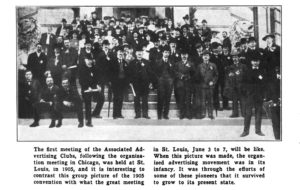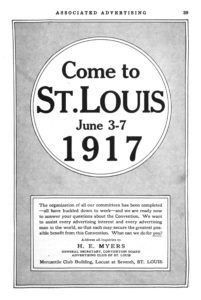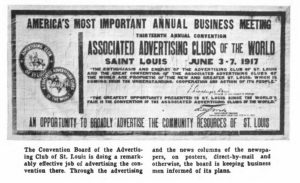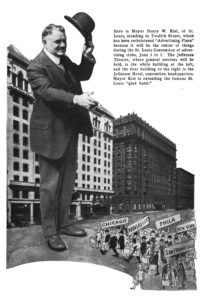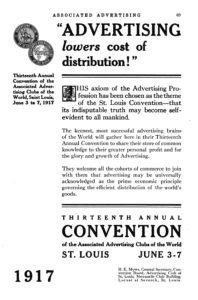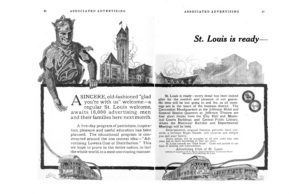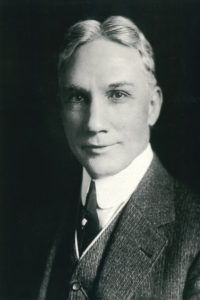1917 — When the advertising world came to STL (Part 1)
“Advertising Lowers Cost of Distribution.” Not quite as catchy as “Meet Me in St. Louie, Louie, Meet Me at the Fair,” but just as effective in drawing guests from around the world to St. Louis –At least advertising men and women guests.
When St. Louis hosted the 1904 World’s Fair, we did not yet know that we’d also be hosting the inaugural meeting of the International Advertising Association (soon to be renamed the Associated Advertising Clubs of the World). We also didn’t know that two years later we’d be hosting the organization’s second convention. And, we definitely didn’t know we’d be hosting: “One of the greatest conventions ever held by any advertising group” from June 3 to 7, 1917.
Over the next couple of blog posts, we’ll share the story, impact and lasting legacy of the 1917 St. Louis convention.
The Sate of Advertising in 1904
The Associated Advertising Clubs of the World (AAC of W) formed in 1904 “to amalgamate advertising organizations into a central body for the purpose of furthering the best interests in advertising.”
As we saw in our first blog post, the advertising business was still in its infancy at the turn of the century. Public trust was waning and the founders of the AAC of W felt that the profession had so many flaws that the only possible solution to fix it was cooperation among the various advertising clubs and organizations.
Then, St. Louis Changes The State of Advertising in 1904
The Advertising Club of St. Louis played a prominent role during the first meeting in 1904 at the Fair’s Festival Hall, our club members held national offices and helped formalize plans in Chicago in 1905 and they all returned to St. Louis for the AAC of W’s second convention in 1906.
In fact, it was Charles H. Jones, a St. Louisan who was also the editor and publisher of an advertising journal, “The Ad Writer,” who planned the whole organization. Before moving his paper to Chicago, Jones discussed his idea and outline for the proposed Federation of Advertising Clubs of America with Ad Club of St. Louis’ secretary and friend, Byron W. Orr (the official name would change to Associated Advertising Clubs of the World at the 1906 convention). Jones wanted to know what Orr thought of the plan and if he felt that other St. Louis advertising professionals would support it. He knew that once he moved to Chicago, he could also rally support there. The first convention in Chicago featured twenty-five St. Louis delegates, second only to the host city of Chicago, plus representatives from Peoria, Cleveland, Detroit, Pittsburgh, Minneapolis, Davenport, Elkhart, Milwaukee, Quincy and New York. The clubs elected Jones their first president in 1905, and elected Orr secretary along with fellow St. Louis Ad Clubber John Phillips as treasurer. Other prominent St. Louis officers of the organization included W. N. Aubuchon (president 1906) and William C. D’Arcy (president 1917 and 1918).
The New Motto? Truthful Advertising
Truth in advertising became the organization’s motto and it featured prominently during the 1905 convention. According to the Association’s Declaration of Principles, “We believe Truth, not only in the printed word but in every phase of business connected with the creation, publication and dissemination of advertising.” (Aim and Object of Advertising Clubs of the World, St. Louis Post-Dispatch, June 3, 1917 pg. C2). This desire for truthful advertising helped rebuild trust and provide a framework for advertising agencies moving forward. Education also played a major role, and one of the goals of the AAC of W’s conventions was educating the general public on the benefits of ethical advertising.
By the way, you may also recognize what the Associated Advertising Clubs of the World eventually became by its current name, the American Advertising Federation. The AAF was also established in 1905. The Advertising Club of St. Louis is a proud member of the AAF and is known as AAF St. Louis.
St. Louis Beats Cincinnati for 1917 Convention with Mops & Posters
During the Associated Advertising Clubs convention in Philadelphia in 1916, St. Louis put on an all-out marketing blitz to edge out Cincinnati and be awarded the host city in 1917. According to reports in the St. Louis Post-Dispatch (June 29, 1916), President M. P. Linn of the St. Louis Advertising Club and Arthur Siegel of the Poster Advertising Company led the charge overnight armed with mops and water pails, while the Cincinnati contingency planned to rise early and chalk the sidewalks and fences. The enthusiastic and preemptive display of modern posters (or as the Post called them “the most modern and effective publicity expedients and devices”) helped St. Louis win the convention.
The article continued to describe why this convention was important to the city, “Advertising men keep in touch with other localities and especially with the development of commerce and industry. They are, in a sense, the guides of the leading men in finance, commerce and industry. Their approval or condemnation means much to a city. St. Louis does not fear their verdict in 1917. This city will be ready.”
St. Louis Is (and always has been) an Advertising City
And, ready we were. The entire city rallied behind the Advertising Club. Plans were made and committees formed for a city-wide “paint up, clean up” campaign to make St. Louis shine. One of the biggest supporters of the Ad Club of St. Louis and the convention was Henry W. Kiel (Mayor of St. Louis from 1913-1925 and the namesake for Kiel Auditorium and Kiel Opera House, now known as Stifel Theater).
As the Associated Advertising magazine said in their April 1917 issue,
“The associated Clubs may meet in many cities in years to come, but no convention can ever be held in a city where the municipal officers give more aid or show a heartier desire to co-operate than in St. Louis.
This is partly due to the fact that Mayor Henry W. Kiel is a member of the club, and as M.P. Linn, president of the St. Louis club said, ‘He is not a Mayor who happens to be a member of the advertising club, but a member of the advertising club who happens to be a Mayor.’” (Associated Advertising, April 1917, pg. 34)
Kiel along with the Board of Alderman, passed an ordinance turning over all the city property that the visiting advertising men and women needed during the convention. Kiel also offered up his office and reception room for the week because he intended to be attending the meetings.
Another appeal of St. Louis was the nearness of all the events. The Jefferson Hotel served as convention headquarters; the Jefferson Theater next door served as the location for general sessions, as did the Municipal Courts Building; and there was an advertising exhibit in the rotunda of City Hall. An inspirational open-air session was held in the Washington University quadrangle. Originally the promise of using the Washington University buildings was one of the strongest factors in awarding the convention to St. Louis until it was noticed that it was a 45-minute ride on the trolley line from downtown’s Jefferson Hotel to Wash U’s campus. The quick thinking of Mayor Kiel to offer the city buildings and to name the areas around 12th Street (Tucker Avenue), Washington Avenue, and Market Street “Advertising Plaza” provided the space 10,000 visitors needed.
As Usual, St. Louis Gets Lit
A special touch awaited the visitors to St. Louis. While all the meeting spaces were within a few minutes’ walk of each other and well-marked with signs by day, strands of new electric lights helped guide the visitors by night. Keep in mind, in 1917 the second industrial revolution, focusing on manufacturing and advancements in electricity, was still advancing. It wasn’t until 1925 that half of the U.S. homes had electric power. However, during the convention, city leaders asked office building owners to leave their street-facing offices lit, as well as homeowners in the area were asked to burn porch lamps to welcome our visitors. As the Associated Advertising magazine wrote in their May 1917 issue, pg. 44, “Truth is golden – and there will be a “Golden Way” in St. Louis during the convention to mark the chief paths the visiting advertising hordes will travel. By special dispensation, the committee of the Advertising Club of St. Louis which has charge of the illuminations will be permitted to place globes of a golden hue on street lamps from the Union Station to the Jefferson Hotel…and that portion of Twelfth Street…which will be re-christened Advertising Plaza. Under the direction of the special committee of the club…St. Louis will be a blaze of light each night of the convention. Over Twelfth Street, in front of the Jefferson Hotel, there will be an illuminated emblem of the Associated Clubs (the Truth Seal), and from it sprays of light will run to the canopy of the hotel to guide the visitor to the very center of things. The city will shine by day and by night.”
To witness the bright lights and “Golden Way” of St. Louis must have been a treat.
They Came from Near and Far
It wasn’t hyperbole to call the Associated Advertising Clubs worldly. In 1917, the AAC of W included more than 175 affiliated bodies located throughout the United States, Canada, Cuba, Hawaiian Islands, and Australia. With early enthusiasm for the St. Louis convention, it was destined to be the largest attendance in the history of the association. Advertising men and women from every corner of the United States made plans to visit St. Louis while others traveled greater distances.
Clubs used their creative expertise to raise funds, awareness, and delegates. The Shreveport (LA.) Advertising Club organized a “100 Club” and pledged to obtain enough old and new members to achieve a 100-person delegation. The Advertising Club of Los Angeles hosted fund-raising smokers and an “Ad Masque” ball. The invitation-only ball included advertising men and women and Hollywood celebrity guests dressed up as popular advertising characters and the Club awarded prizes for the best costumes. The Nashville and Denver Advertising Clubs each hosted symphony concerts to raise money for their delegates.
Texas, New York, Indiana, and Chicago clubs boarded special rail cars and Minneapolis/St. Paul and Quincy, Illinois Clubs steamed down the Mississippi, while the San Francisco Advertising Club decided to promote themselves and their upcoming 1918 convention by driving 2500 miles for the first west-to-east tour of its kind ever executed. Over 20 Buick motor cars took 100 passengers 13 days to drive through the Rockies, Reno, Salt Lake City, Pueblo, Hutchinson, Kansas City, and Columbia before rolling into downtown St. Louis on June 3rd. During this cross-country trek, they averaged 200-250 miles a day at a speed of 20 miles an hour and averaged 10 hours of driving a day. One car was even decorated as a covered wagon. Yes, it was that slow. You could say 1917-slow.
Perhaps the greatest distance traveled belonged to J. Wright Sutcliffe, an advertising consultant from Johannesburg, South Africa. Sutcliffe traveled 10,000 miles to meet in St. Louis and even left Johannesburg early to make up for any delays he might encounter due to the war (Associated Advertising, May 1917, pg. 44).
Part II – in our next Ad Club STL 120 blog post, join AAF St. Louis as we share more on the pageantry, patriotism, parades, and new president from the Advertising Club of St. Louis elected at the 1917 Associated Advertising Clubs of the World Convention
- Group Picture of The 1905 Convention
- 1917 Convention Ad
- 1917 Convention Ad with Commentary
- 1917 Convention Ad featuring Mayor Kiel
- 1917 Convention Ad
- Advertising Club of St. Louis 1917 Convention Welcome
- D’Arcy’s 1917 Convention Welcome
- St. Louis Chamber of Commerce 1917 Convention Welcome
- Convention Board of Advertising Club at St. Louis
- M. Palmer Linn, President of Advertising Club of St. Louis 1915-1917

